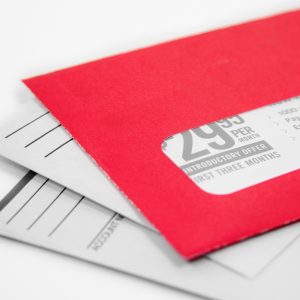Wondering where to begin with your direct mail campaign? Starting to design a direct mail piece can be daunting. There are so many regulations to think about, such as where the indicia goes, how much space to leave for the barcode, and more. Plus, the postal service charges more if a piece isn’t the correct size or if it needs to be sent back because required data is in the wrong place.
Moreover, direct mail encompasses a wide array of marketing formats such as catalogs, postcards, brochures, letters, inserts, newsletters, and more. Which part of the direct mail piece is regulated? There are so many questions, you may be wondering where to start.
This article will give you comprehensive details on regulations and design aspects so you can set up your direct mail piece like a pro – ensuring it runs smoothly through mail machines and makes the most of your investment.
Regulations for Setting Up Direct Mail Pieces
There are specific regulations you must abide by when it comes to setting up a direct mail piece. The Postal Service has published the U.S direct mail postage regulations to help you create direct mail pieces. Ensure that you design a direct mail piece correctly by addressing postal regulations. This can also prove to be the most cost-effective way to save on postage and improve your delivery time.
Retail Direct Mail Regulations
These regulations apply to a single-piece direct mail letter, such as a thank-you letter or routine business correspondence. The minimum letter size is 5 inches long, 3.5 inches high, and 0.007 inches thick.
The maximum size is 11.5 inches long, 6.125 inches high, and 0.25 inches thick. The weight should be under 3.5 ounces; otherwise, a flat mail rate will apply. The letters must be rectangular with square corners. A direct mailing piece with odd-shaped corners may require you to pay higher postal rates.
Design Requirement
The design requirements are as follows:
- The maximum weight of your letter should be 1 ounce, including the envelope.
- Your postcard or share mail letter must fill the eligibility criteria of first-class mail.
- The address can be printed or handwritten, and the destination must be within the U.S. or addressed to the APO/FPO/DPO location.
Related: How to Get Extremely Targeted With Direct Mail
Before you distribute the direct mail pieces, you must also comply with the following specifications.
- The Postal Service requires you to use an Intelligent Mail barcode (IMb). These are account-holder-generated barcodes to track and count your direct mail postcards and letters. The IMb makes the payment and reporting convenient.
- Your IMb must include your unique Mail ID (MID). The Postal Service supplies this to you to identify your account and the mail associated with your account. You can use the MID for postcards and share mail letters. However, you can use the same ID for other mail pieces too.
- Your direct mail pieces, such as postcards and share mail letters, must also have a special Facing Identification Mark (FIM E). This allows the Postal Service to orient your direct mail pieces for processing. However, you do not have to use the FIM E for pieces other than share mail letters.
- The Indicia must be visible on the upper right-hand corner of your direct mail piece’s address side.

Tips to Design a Direct Mail Piece for Mailing
Design plays a crucial role when it comes to setting up your direct mail piece. It involves more than just imagery and colors. A good design must adhere to your brand identity and create a cohesive and recognizable brand image.
Related: How to Design for Direct Mail Print Pieces
Know Your Audience – Understanding your target customers will allow you to create a direct mail piece with a persuasive design. You will also know how much information your consumers need.
Know the Intent of Your Direct Mail Piece – It’s essential to know the intent behind setting up direct mail. Why are you starting this campaign? What do you wish to achieve from it? This will help you nail the message you wish to send. Moreover, you will be able to use the right format and imagery.
Choosing the Right Format – Your format dictates the number of images and copy you will be able to fit into a direct mail piece. If you wish to provide extensive details, then a brochure is ideal. If it’s a one-time promotion, such as a sale announcement, then a postcard or coupon format is cost-effective.
Strategy With Fonts – The font will play a significant role in your consumer’s perception of your direct mail piece. Therefore, you must stick to one (or a maximum of two) typefaces and stay away from flashy fonts. You do not want your consumers to decipher a jumbled font to read your message. Moreover, try using different font sizes to add visual interest. For example, the offer must appear in a larger font size as that will be your hook to entice the consumers.
Utilizing White Space – Using white space is an essential aspect of your direct mail piece’s design. Incorporating white space between different design elements, such as your logo, will keep it clean and prevent cluttering.
Using Images Wisely – Carefully chosen images will attract consumer attention and increase the chances of them reading the direct mail piece. Lifestyle imagery is always the best way to lead, especially if these are images of people using your product or services. This will help your prospects to identify with your product and how your brand can enhance their lifestyle. Always use high-resolution images, which should be 300 dots per inch (dpi). Avoid busy backgrounds and make sure that the photos do not contain any text.
The Highest Cost Element
Postage can be one of the most expensive components of your direct mail piece. This is a variable cost that depends on the volume and size of your direct mail piece. Therefore, it is crucial that you stay within the USPS weight and size guidelines.
While you may control other elements of your direct mail piece, the postage element pretty much stays the same, as USPS has predetermined rates for the size and weight of each piece you send.
Conclusion
When it comes to setting up your direct mail piece for mailing, there is no perfect plan. However, you must always ensure that your design complies with regulations and depicts a positive brand image to your audience. The above-mentioned elements will help you create a unified direct mail piece that your prospects will engage with and respond to. To get your next direct mail campaign off the ground and into mailboxes, contact the experts here at Ironmark. Our print specialists know just what your campaign needs.




